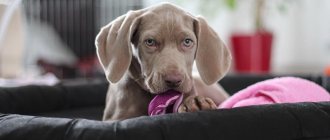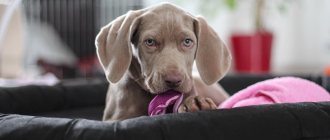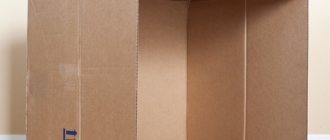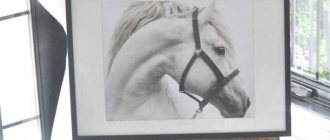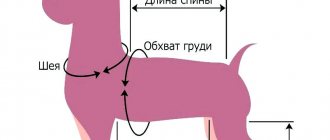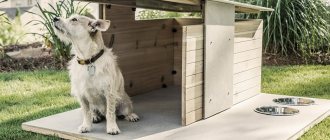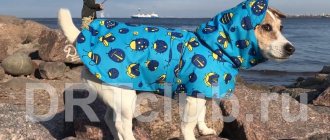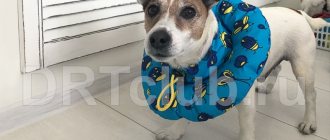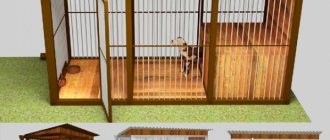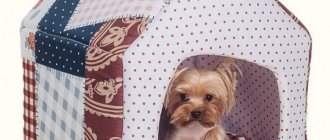A dog in the house is part of the family and a person’s friend. This is a very active animal that constantly requires attention and care. But even such a hyperactive animal must rest, and a separate place must be provided for this. Just like a person, a dog needs its own bed - a couch. Naturally, you can buy it in specialized stores, or you can build it yourself if you have the necessary material, free time and the desire to make something unusual and beautiful for your pet. But before creating a resting place for your dog, you need to consider several points that will make your dog’s rest more comfortable.
Types and features of beds
The fabric for the bed should be as dense as possible so that the dog does not damage it with its claws.
The characteristics of the dog's coat also play a role. For example, for smooth-haired dogs, the most suitable materials for a bed are velor and plush. Those dogs with thicker coats will feel most comfortable on linen, cotton or denim.
For large dogs, it is better to choose carpet products. For small and decorative breeds, it is better not to choose carpet and some rough materials, but to choose something softer and more natural, for example, linen or velor.
For animals, it is better not to take synthetics; this will negatively affect them, including allergies.
Of course, you need to take into account the size of the animal, its preferences and habits. It is advisable to see how the dog goes to sleep: stretched out to its full length or folded into a lump. You need to take this as a starting point when choosing the shape of your future lounger.
For internal padding, it is best to use foam rubber, holofiber and batting.
Before creating a lounger, you need to allocate a certain place in the house or apartment so that the animals are warm and comfortable, there is no wind or too strong sunlight.
But don’t forget that your pet’s bed should be placed somewhere nearby, not in a far corner.
It is important for your pet to see you and be constantly near you, so it is better to equip a bed somewhere next to your bed or sofa.
The finished bed must be constantly treated with antimicrobial agents.
A removable pillow should be placed in the pet's bed, which can be easily pulled out and washed.
Content Rules
From a technical point of view, housing the representatives of the German Shepherd breed is accompanied by the need to solve some problems. The first such problem is the noticeable molting of the animal. During the shedding process, it is necessary to remove fur and vacuum the room several times during the day. Among other things, a large dog has a rather specific “dog” smell, which can be very difficult to get rid of even if you follow the rules of hygiene.
Hygiene, bathing, grooming
Proper care of the coat is a guarantee of maintaining the appearance and health of the German Shepherd . Faded, dull, falling out dog hair often indicates health problems, an unbalanced diet or improper care of the pet. It is recommended that a German Shepherd puppy be taught to carry out all hygiene procedures from a very early age. It is important to purchase the following set of grooming tools:
- massage comb with frequent metal, fairly long teeth;
- slicker comb for combing your pet during seasonal shedding;
- metal comb for combing hair;
- dog special shampoo;
- conditioner balm for animal hair care.
The coat of the German Shepherd consists of coarser hair, long guard hairs and a soft, dense undercoat. A couple of times a year, shepherd dogs experience a natural physiological process, and the seasonality and intensity of shedding directly depends on the characteristics of how the dog is kept. In addition to seasonal, there is age-related molting, which occurs in the process of replacing puppy, “children’s” hair with an adult, harder coat.
In bitches during the postpartum period or at the end of lactation, hair replacement may also occur. At this time, the coat requires special, daily care. Brushing the coat twice a day accelerates the loss of dead hair, has a positive effect on the condition of the skin, and also minimizes the accumulation of hair on furniture or carpets. Particular attention is paid to the tail, feathers and sides.
This is interesting! Grooming is permissible immediately before the exhibition of a German Shepherd, but it is advisable to carry out such training of the dog in special salon conditions, which is due to some of the characteristics of the coat of representatives of this breed.
German Shepherds take water and bathing quite well, but the puppy must be taught such hygienic procedures from an early age. It is recommended to bathe dogs kept in apartment conditions two to four times throughout the year. It is best to carry out such activities after molting, before an exhibition, or a few days before preventive treatment against ectoparasites. After a walk, dirt from the coat is removed with a damp towel. In summer, water procedures can be tripled in the shower.
Diet, diet
Keeping a service dog requires strict adherence to basic nutritional rules:
- food is given at a strictly defined time;
- after feeding, the bowl is thoroughly cleaned;
- An adult German Shepherd needs to be fed a couple of times a day;
- food is given warm, which will prevent the development of gastrointestinal diseases;
- when feeding granulated dry food, free access to water is mandatory;
- It is necessary to use adapted stands for bowls, which will form the correct posture of the dog.
This is interesting! Flour products and fresh baked goods, legumes and potato dishes, sugar-containing products, pickles and smoked foods, spicy and pickled products, bones, as well as sausages, sausages and small sausages are strictly prohibited.
The best option is to feed premium dry diets, the composition of which includes meat, cereals and vegetables, natural fats, as well as a vitamin and mineral complex with a high energy indicator. These foods have a balanced content of all ingredients.
Education, training
Representatives of the German Shepherd breed have several undeniable advantages, including an excellent aptitude for education and training. It is necessary to train such a dog throughout the entire period of growing up of the pet, until approximately one year of age. Only in this case, all commands are firmly assimilated and used by the dog throughout his life.
Between the ages of two and four months, the puppy is accustomed to a place, collar and leash . When walking, the dog must be taught to be indifferent to cars, passers-by and other animals. Successful training is based on strict execution of commands followed by praise and encouragement. The command is voiced once and is accompanied by a gesture.
This is interesting! The universal breed is distinguished by good intelligence, well-developed intuition and the ability to quickly perceive commands given by the owner, and can also behave boldly, confidently and decisively in any situation.
It is important to observe the sequence of orders given and the demonstration of gestures, as well as pay attention to the presence of a positive attitude in the dog and the owner himself. The lesson should be completed by the team that performs the shepherd better than others.
Diseases, vaccinations
Typical diseases of the German Shepherd are some viral, parasitic and genetic diseases:
- plague, or Kare's disease;
- infectious hepatitis, or Rubart's disease;
- leptospirosis;
- rabies;
- demodicosis;
- fleas;
- hemophilia;
- panostitis;
- underdevelopment of the kidneys;
- myelopathy;
- hermaphroditism.
The most common genetic diseases include various vision disorders, including cataracts and corneal dystrophy, as well as elbow and pelvic dysplasia. Vaccination of German Shepherds must be carried out for the safety of both the pet and its owner. The first vaccinations for a German Shepherd puppy should be given no earlier than two months of age. Representatives of the breed should be vaccinated against the following diseases:
- adenoviral enteritis;
- infectious hepatitis;
- parovirus infection;
- parainfluenza;
- carnivore plague;
- respiratory tract adenovirus;
- leptospirosis;
- rabies.
This is interesting! After vaccination, it is strictly not recommended to walk your pet for several days or change the usual diet and diet, and it is also important to minimize contact with other pets.
Veterinary clinics often develop their own schedules for vaccinating dogs with various polyvalent and monovalent drugs. Before vaccination, antiparasitic treatment is mandatory, as well as an external veterinary examination of the dog.
Return to content
Materials and tools required for work
In most cases, to make beds with your own hands you need such a set of materials. But depending on the materials, decorative elements or features of the blank for the bed, they may change.
Basic materials and tools for robots:
- thick pattern paper or cardboard;
- a pencil for drawing a drawing (to transfer the pattern to the fabric you need to use dry soap or chalk);
- ruler;
- tailor's scissors for cutting material;
- any thick fabric that is suitable for your dog;
- material for stuffing the bed (sintepon, foam rubber, batting);
- dense threads that can efficiently hold dense fabric together;
- large sewing needles or sewing machine.
Reviews about the shepherd in the apartment
If you decide to purchase a German Shepherd for apartment living, then you should initially take care of the safety of the living space . It is important to hide all objects that the puppy can reach and damage (shoes, wires, plants and children's toys). According to owners of dogs of this breed, special attention needs to be paid to ensuring sufficient physical activity and frequent walks.
This is interesting! The animal must be fully socialized, which will make it possible to control the behavior of a representative of such a large breed on the street and in crowded places with people or other pets.
An equally important aspect of keeping a shepherd in an apartment is, according to experts, the ability to provide the four-legged pet with complete, high-quality, balanced nutrition. Caring for a long-haired breed involves regularly performing the entire range of hygiene measures, which are especially important during the period of active shedding. It is highly undesirable for dog breeders who are too busy with work to have this large pet in an apartment.
Return to content
Dog bed: pattern for beginners
For the most ordinary square dog bed in the form of a pillow, you will need to measure the animal.
A few tips for determining the size of the lounger pattern:
- To calculate the length of the pattern, you need to measure the dog from the base of the tail to the nose.
- If you are going to make a sunbed with sides, then add another 10-20 cm.
- In order to understand what size is best to make the width of the bed, you need to measure from the pads of the paws to the dog’s croup. Increase the resulting size by 2 times.
Another unusual pattern from which you can sew a long dog bed pad.
Pattern "Bone"
Having measured the dog and calculated the length, you need to draw a large bone on paper that matches the calculated dimensions.
To make the bone even, you need to draw it using a compass.
You need to place a rectangle in the center, and at the edges from each corner of the rectangle you will need to draw 4 circles. You will get the shape of a bone.
If you show some imagination, you can create a beautiful dog bed from various materials.
After all, store-bought beds do not always correspond to the size of the dog or its position when it sleeps, and the animal will be uncomfortable. Therefore, if desired, any owner can create an unusual, decorative and comfortable sleeping place for his beloved pet.
Relationship with family members
A reliable, fearless, non-conflict, hardworking and balanced German Shepherd requires timely implementation of its innate abilities. Unlike many other dog breeds, the German Shepherd recognizes not only its owner in the family, so such pets communicate with all family members with great pleasure.
Relationships with adults
German Shepherds are wary and suspicious of any strangers. The dog will very carefully monitor all movements of a stranger, maintaining a constant readiness to protect its owner and family members. However, such behavior does not mean at all that representatives of the service breed are capable of showing any unmotivated aggression towards people passing by. Such a four-legged pet takes only adequate response actions.
To maintain the correct behavior pattern, it is very important to socialize your German Shepherd in a timely and competent manner. The methods of raising and socializing a large dog are unchanged, but owners of male dogs of this breed need to be more persistent in the learning process. However, their sharp natural intelligence and boundless devotion to their owner have made the breed very popular in many countries around the world.
Relationship with children
The German Shepherd loves children very much, and also perfectly understands that such family members must be treated not only affectionately, but also with great care. Adult representatives of the breed take care of and always protect the owner’s children, and also play outdoor games with them with great pleasure. The German Shepherd is quite capable of taking on some simple responsibilities, including protecting the baby from animals and strangers.
Return to content
Labrador personality traits
A dog like a Labrador has a character that fully corresponds to the purpose of breeding - this is the character of a hunting dog, designed to track and pursue prey. He absolutely loves being in water - pools and ponds have an attractive force for him. Their active behavior is also based on the principles of hunting behavior.
Advertising:
Labradors are very loyal to their owners - such a dog is extremely attached to the owner and all family members. They are generous and practically devoid of selfishness. The habit of being happy for any reason can sometimes seem too intrusive and problematic, becoming a source of constant chaos in the house.
Labradors are very attached to their owners
However, at the same time, the Labrador is a loyal and loving friend who is always ready to help. As a watchdog, he is absolutely useless, since he welcomes the arrival of guests - for strangers he will be a friendly butler, and not a strict guard.
Soft pillow or hard mattress?
If the dog is used to sleeping on a soft bed, then it is better to use a soft pillow stuffed with holofiber as a mattress.
It is desirable that it be made of anti-vandal furniture fabric; in fact, it can be ordered from us. A hard mattress based on foam rubber is worth choosing if the dog prefers to sleep on the floor, carpets, and sofas. These mattresses are most practical for large dog breeds.
We recommend purchasing pillows and mattresses with an additional zippered cover so that you can replace it with a clean one at any time.
Where to place a place to rest
A dog bed should be placed in a place where the animal likes to sleep. It can also be a quiet, secluded place, not on the aisle, but the pet must observe the movements of people in the room. This way the animal will not experience loneliness.
The pet's sleeping place should be protected from drafts, so the bed should not lie on the bare floor, but should be at a distance from the floor (8-10 cm). If there is a heated floor, then the bed can be placed directly on it. It is also worth remembering that it may be uncomfortable for your pet to sleep near a radiator, electrical appliances, or windows.
Dog's resting place
Please note! Choosing the right location for the bed is an important aspect of ensuring the dog’s psychological comfort, so it must be taken seriously.
Selection rules
You can purchase a high-quality dog bed in zoological stores, online resources, and also directly from the manufacturer. When choosing a product, it is recommended to pay attention to important points:
- Design: it can be a house, a lounger with sides, a playpen or a heated bedding;
- Size: Beds of different sizes are sold for large and small breeds. You need to choose one on which the dog can lie down in a way that is comfortable for him;
- Material: plastic or fabric – it’s up to the owner to decide;
- Manufacturer: today in the pet products market, the companies producing beds are Ferplast, Jusi, Triol, Fop and others.
If you wish, you can additionally arrange a dog bed in any room of the house so that the dog is always nearby and has its own place in each room. Care and careful use of the bed will extend its service life.
Types: people are cunning at inventions
If you want to create something like this, you can use the “recipes” you found: repeat all the steps exactly or let your imagination run wild and bring in original ideas.
Everything for your pet - sweater, sweatshirt
This option is good because it does not require fiddling with patterns, which means the manufacturing process will not take much time. Minimum required:
- sewing supplies;
- an old (if not a pity, then a new) thick sweater or sweatshirt;
- filler, it is better to take a high-quality one;
- pillow or piece of foam rubber;
- a small piece of fabric (20x50).
Clothes are turned inside out. Sew up the collar, leaving a small area. Turn it right side out again. Having laid out the product on a plane, draw a line connecting the lower parts of the armholes. Having basted along it, the sweater is sewn. The inner seams of the sleeves are manually sewn to the side seams, not reaching their end.
Improvised sides are filled with filler, for example, padding polyester. A pillow (foam rubber) is placed in the middle of the future bedding, the bottom of the sweater is sewn up, and the cuffs are connected to each other. The place where they meet is covered with a piece of fabric, which is also quilted by hand. To fix the side at the front in several places, sweep it with a cushion bottom.
The simplest “hiking” option
This is a good choice for those dogs whose owners often travel with their four-legged friends. And such bedding will not hurt at home. To make it, you need to add a pencil (crayon) and pattern paper to your sewing supplies.
After measuring the “dimensions” of the tailed household member, the dimensions are transferred to paper. The shape is usually either square or rectangular. The pattern is cut out and transferred to fabric folded in half with the wrong side up. Trace the contours, not forgetting to leave seam allowances (1 cm). The material is sewn together, leaving space on one side for filling with sawdust or a more noble filler.
After joining, the bed is turned right side out, the filling is placed inside, and the hole is sewn up. If the owners want to periodically change the “insides” of a product, it is recommended to sew in a zipper to make it easier to change the filling. A few pillowcases made of soft fabric will not be superfluous. One of the sides is left unsewn or also provided with zippers.
More “advanced” model
This bedding is suitable for those housewives who are allergic to sewing work. Necessary materials to create a stationary bed:
- foam rubber, fabric;
- rolls (for example, leftover from foil, paper towels, cling film);
- tape, stapler, scissors, knife;
- fiberboard sheet.
Using a pattern, the dimensions are transferred to fiberboard, foam rubber and fabric. On the last one, be sure to leave allowances for hemming. The filler is placed on the slab and secured with tape. Then the “semi-finished product” is wrapped in fabric, which is secured with a stapler.
Pieces of foam rubber are wound onto rolls. Having secured them with tape, they are also wrapped in fabric, then fixed with a stapler around the perimeter of the litter. One side is left without sides. A necessary element that will still have to be sewn is a pillowcase-cover; it is better to make several at once for a change.
Round cozy “nest”
This kind of bedding can be called “professional”, so it requires a pattern. However, the work cannot be called super complex.
Frame Installation: Complete Guide
When building a booth from plywood, covering it with fabric inside and decorating the outside, the main load is borne by the frame. Its assembly begins with connecting the bottom and side walls. First, the bottom and floor are cut out if you plan to make it double, so that you can take the booth out into the yard at the dacha.
The next step is assembling the side walls - cutting out sections of bars for the vertical posts and horizontal crossbars. The connection is made using self-tapping screws.
After assembling the side walls, the front and rear walls are installed. To strengthen the structure, the inside is lined with thin plywood or chipboard. The sheathing is secured with small nails.
Plywood house
